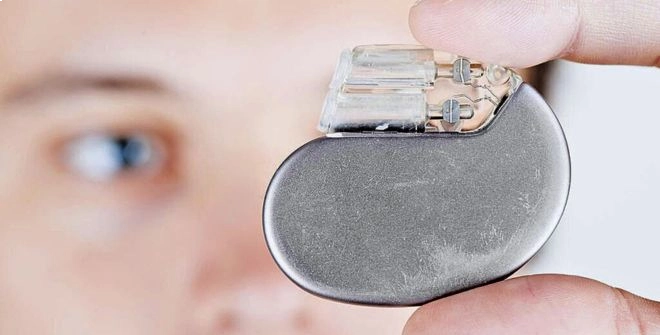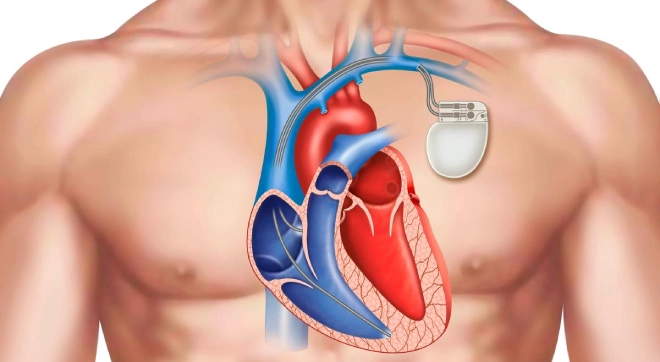Pacemaker
A pacemaker is a small device implanted in the chest of individuals with congestive heart failure or other conditions that affect the normal electrical activity of their heart. It sends electrical impulses to the heart muscle, which helps regulate its contractions and maintain a steady Rhythm.

Pacemakers are important for patients with CHD (Congential Heart Disease) as they help regulate their heartbeat and keep it within a safe range. Pacemakers are medical devices that can significantly improve the quality of life for individuals experiencing symptoms like shortness of breath, dizziness, fainting, and chest pain. By regulating heart rhythms, they help reduce these symptoms and minimize the Risk of Cardiac arrest. at Cardiomet Clinic, Dr. Abhijeet Palshikar offers expert care and Pacemaker treatment in Pune.
Types of Pacemakers
There are three main types of pacemakers:
- Single-chamber pacemakers have one lead (electrode) inserted into the right ventricle and only pacing to this chamber. Single-chamber pacemakers are suitable for conditions such as bradycardia and SA node dysfunction.
- Dual-chamber pacemakers have two leads – one connected to the right atrium and one to the right ventricle. They provide pacing to both chambers and can detect heart rhythms in both chambers. Dual-chamber pacemakers help reduce symptoms associated with bradycardia, tachycardia, atrial fibrillation, and other Arrhythmias.
- Biventricular pacemakers have three leads – two on the right and one on the left. These specialized pacemakers treat congestive heart failure by simultaneously providing electrical stimulation to both ventricles, optimizing their contractility.
- Leadless pacemakers are the latest type of pacemaker. These devices are much smaller than traditional pacemakers and can be inserted under the skin without requiring any leads or wires. They are attached to a thin metal anchor and do not require cords or tubes to connect them to an external device.

Pacemakers have revolutionized the treatment landscape for individuals grappling with Congenital Heart Disease (CHD), providing them with life-saving options that alleviate symptoms and enable a return to everyday activities.
Despite advancements in pacemaker technology, the procedure for insertion has remained relatively constant. Prioritizing discussions with your healthcare provider is essential to evaluate the appropriateness of a pacemaker for your specific condition. at Cardiomet Clinic, Dr. Abhijeet Palshikar Pacemaker surgeon in Pune, offers ensuring exceptional care.
Reasons for Pacemaker Implantation
Pacemakers are implanted as a preventative measure or to treat Cardiac Arrhythmias. Pacemakers regulate the heartbeat in cases of bradycardia, heart block, and other arrhythmias. The device is small, usually composed of a generator and one or two electrodes inserted into a heart chamber.

Pacemakers help to regulate the heartbeat by delivering electrical signals to the heart when it needs stimulation, increasing its rate if necessary. This ensures that the heart maintains an appropriate rhythm and helps reduce symptoms associated with cardiac conditions, such as fatigue, shortness of breath, dizziness, and chest pain.
Pacemaker implantation plays a vital role in enhancing the quality of life for individuals with cardiac conditions like bradycardia and heart block.
By regulating the heartbeat and averting abnormal activity, pacemakers bring a sense of stability and peace of mind to those who have faced heart arrhythmias. However, it is essential to understand the Differences Between Heart attack and Cardiac Arrest as these medical conditions possess distinct risks, causes, treatments, and outcomes.
Pacemaker Implantation Procedure
The surgical procedure involves inserting leads and a generator into the chest. Before the procedure, patients must undergo tests to determine their suitability for surgery and may need to provide consent forms or health insurance information.
Patients are usually given local anesthesia or sedation during the procedure. The incision site is then sterilized before the surgeon implants the pacemaker leads in the heart chambers. A generator is then inserted into a pocket underneath the skin on either side of the chest and connected to the leads.

Finally, an X-ray may be taken to check that everything has been correctly positioned before dressing and closing the wound.
After undergoing pacemaker implantation, it's natural to feel a mix of emotions. The road to recovery typically spans around two weeks, during which it's crucial to prioritize self-care and avoid strenuous activities that could hinder your healing process. Taking the time to nurture yourself and allowing your body to adjust to the new Pacemaker is essential.
Remember, your Pacemaker is a Precious lifeline, so be mindful of extreme temperatures and potential sources of interference. Regular check-ups with your caring doctor or cardiologist will provide reassurance and ensure your heartbeat remains steady.
For Pacemaker Specialist In Pune, Consider Reaching Out to Dr. Abhijeet Palshikar at Cardiomet Clinic and take the first step toward your Recovery Journey by Book an Appointment today.
Potential risks and complications
Potential risks and complications associated with pacemaker implantation include bleeding, infection, lead displacement, damage to major blood vessels and surrounding tissue, and pericardial effusion (fluid around the heart), which can cause difficulty in breathing or palpitations. Additionally, there is a small risk of an allergic reaction to local anesthesia used during the procedure.

Occasionally, pacemakers may fail due to malfunction or device-related issues such as a blocked battery or defective leads. In some cases, patients may also experience interference from external sources such as cell phones or microwaves. To minimize these risks and any potential complications, patients must adhere to post-operative care instructions provided by the doctors.
Living with a Pacemaker
Living with a pacemaker requires individuals to take extra precautions and care. It is important to regularly check the device for any signs of malfunction and notify your doctor if you experience any changes or symptoms.

To maintain a healthy lifestyle, individuals should eat a balanced diet and avoid processed foods as much as possible. Additionally, regular physical activity can help to manage symptoms associated with the pacemaker, such as fatigue or muscle soreness. However, checking with your doctor before engaging in strenuous activities is important. Other tips include:
- Avoiding exposure to extremes of temperature.
- Keeping away from potential sources of interference such as cell phones and microwaves.
- Getting lots of rest.
It is also essential for those living with pacemakers to attend follow-up appointments and undergo regular testing for doctors to identify any problems early on. This kind of ongoing medical care can ensure the device works properly and help monitor changes in your heartbeat rate over time.
Addressing the concerns over pacemakers
Many individuals considering or having already received a pacemaker implant may have questions and concerns about how it will affect their lifestyle and well-being. First and foremost, it is important to remember that with appropriate medical care, individuals can lead relatively normal lives while living with a pacemaker.
However, there may be lifestyle restrictions due to the device, such as avoiding activities involving strenuous physical exertion or extreme temperatures. Individuals should also take extra precautions when engaging in activities such as swimming or diving.

When it comes to device maintenance, patients will need to follow instructions provided by their doctor for regular check-ups and testing. These tests help ensure the device is working properly and there is no risk of infection or malfunctioning parts.
Patients should also be aware of potential sources of interference from external sources, such as cell phones which could interfere with the pacemaker. Individuals living with pacemakers must maintain an open dialogue with their doctors about any concerns regarding their condition.


